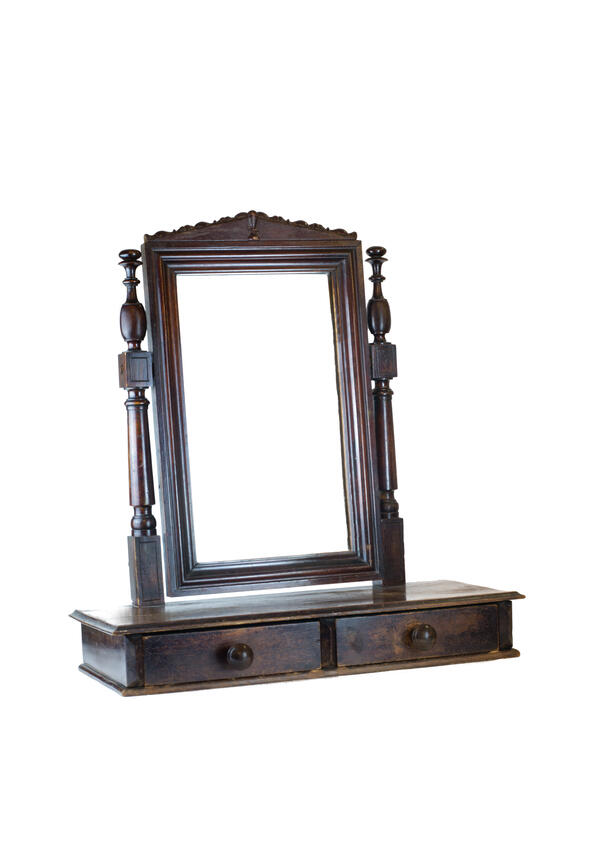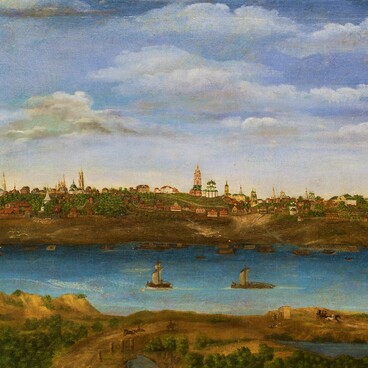The first glass mirrors appeared in 1240 when in Europe, they learned to blow glass vessels. In 1279, the Italian monk John Peckham described a method in which the glass surface was covered with tin — it was poured into a vessel in melted form through a special tube. The tin spread evenly over the glass, and when this ball froze, it was broken into fragments. Gradually, workshops began to appear in different countries, where mirrors were made and improved.
The vanity mirror from the museum’s collection was created at the beginning of the 20th century. As a rule, such models were intended not for merchant houses, but simple urban dwellings and people of poor estates.
The mirror has a simple design. It is portable, rectangular, and under it, there are small drawers for small things necessary for a ladies’ routine or needlework. The mirror is framed by a wooden frame and processed by carpentry and turning machines. The upper part is crowned by a corner cornice with carved ornaments, and on both sides, there are shaped columns.
The item belonged to Esther Kessler, a resident of the small Belarusian town of Shklov. She came to Murom with her father, Solomon Kessler, in 1927. Her mother, Lyubov Kessler, worked as a maternity nurse. She died early, at the age of 40. Her daughter brought the mirror to Murom along with the sewing machine called “Zinger”.
Kessler’s paternal grandfather was a rabbi, and her maternal grandfather floated timber on rivers and traded it but later went bankrupt. Esther Kessler and her two sisters were supported by her father, who worked as a chief accountant at a stationery factory in Murom. The earnings were small, but the family was not poor.
After Esther Kessler got married, she moved the mirror to her husband’s apartment. Later, she always took it with her — along with the Zinger sewing machine. After Kessler’s death, the mirror was given to the museum.
Similar interior items were often found in Murom. Accessories in the Art Nouveau or Art Deco style are shown on the museum mirror: perfumes, compact boxes, whitewash and blush, combs and others. They belonged to different women who lived in Murom about a hundred years ago.
The vanity mirror from the museum’s collection was created at the beginning of the 20th century. As a rule, such models were intended not for merchant houses, but simple urban dwellings and people of poor estates.
The mirror has a simple design. It is portable, rectangular, and under it, there are small drawers for small things necessary for a ladies’ routine or needlework. The mirror is framed by a wooden frame and processed by carpentry and turning machines. The upper part is crowned by a corner cornice with carved ornaments, and on both sides, there are shaped columns.
The item belonged to Esther Kessler, a resident of the small Belarusian town of Shklov. She came to Murom with her father, Solomon Kessler, in 1927. Her mother, Lyubov Kessler, worked as a maternity nurse. She died early, at the age of 40. Her daughter brought the mirror to Murom along with the sewing machine called “Zinger”.
Kessler’s paternal grandfather was a rabbi, and her maternal grandfather floated timber on rivers and traded it but later went bankrupt. Esther Kessler and her two sisters were supported by her father, who worked as a chief accountant at a stationery factory in Murom. The earnings were small, but the family was not poor.
After Esther Kessler got married, she moved the mirror to her husband’s apartment. Later, she always took it with her — along with the Zinger sewing machine. After Kessler’s death, the mirror was given to the museum.
Similar interior items were often found in Murom. Accessories in the Art Nouveau or Art Deco style are shown on the museum mirror: perfumes, compact boxes, whitewash and blush, combs and others. They belonged to different women who lived in Murom about a hundred years ago.



